
A semi-trailer truck, is the combination of a tractor unit and one or more semi-trailers to carry freight. A semi-trailer attaches to the tractor with a type of hitch called a fifth wheel.

A road train, also known as a land train or long combination vehicle (LCV) is a semi-truck used to move road freight more efficiently than single-trailer semi-trucks. It consists of one semi-trailer or more connected together with or without a tractor.
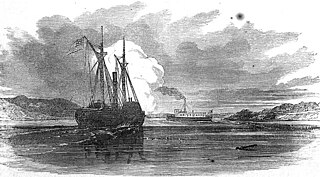
A tugboat or tug is a marine vessel that manoeuvres other vessels by pushing or pulling them, with direct contact or a tow line. These boats typically tug ships in circumstances where they cannot or should not move under their own power, such as in crowded harbors or narrow canals, or cannot move at all, such as barges, disabled ships, log rafts, or oil platforms. Some are ocean-going, and some are icebreakers or salvage tugs. Early models were powered by steam engines, which were later superseded by diesel engines. Many have deluge gun water jets, which help in firefighting, especially in harbours.
Semi- is a numerical prefix meaning "half". The prefix alone is often used as an abbreviation when the rest of the word is clear from context.

Pegaso was a Spanish manufacturer of trucks, buses, tractors, armored vehicles, and, for a while, to train apprentices, and have a good brand image, some sports cars. The parent company, Enasa, was created in 1946 and based in the old Hispano-Suiza factory, under the direction of the renowned automotive engineer Wifredo Ricart. In 1990, Iveco took over Enasa, and the Pegaso name became a secondary brand of Iveco.

A trackless train — or tram, road train, land train, or parking lot train is a road-going articulated vehicle used for the transport of passengers, comprising a driving vehicle pulling one or more carriages connected by drawbar couplings, in the manner of a road-going railway train. Similar vehicles may be used for transport of freight or baggage for short distances, such as at a factory or airport. Often depending on use, land train may or may not be skeuomorphically styled to look like traditional, often steam trains.
Artic or ARTIC may refer to:
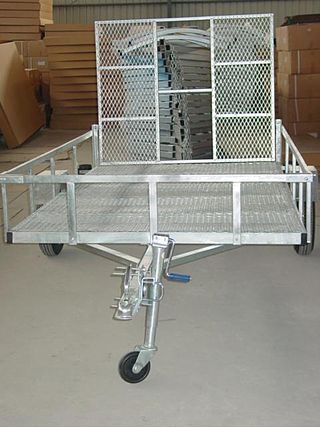
A trailer is an unpowered vehicle towed by a powered vehicle. It is commonly used for the transport of goods and materials.

A large goods vehicle (LGV), or heavy goods vehicle (HGV), in the European Union (EU) is any lorry with a gross combination mass (GCM) of over 3,500 kg (7,700 lb). Sub-category N2 is used for vehicles between 3,500 kg and 12,000 kg (26,000 lb) and N3 for all goods vehicles over 12,000 kg as defined in Directive 2001/116/EC. The term medium goods vehicle is used within parts of the UK government to refer to goods vehicles of between 3,500 and 7,500 kg which according to the EU are also "large goods vehicles."
Scammell Lorries Limited was a British manufacturer of trucks, particularly specialist and military off-highway vehicles, between 1921 and 1988. From 1955 Scammell was part of Leyland Motors.
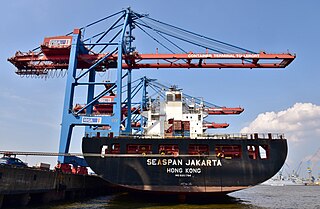
Seaspan ULC provides marine-related services to the Pacific Northwest. Within the Group are three shipyards, an intermodal ferry and car float business, along with a tug and barge transportation company that serves both domestic and international markets. Seaspan, is part of the Washington Companies that are owned by Dennis Washington. Kyle Washington, is the Executive Chairman of Seaspan, who has become a Canadian citizen.
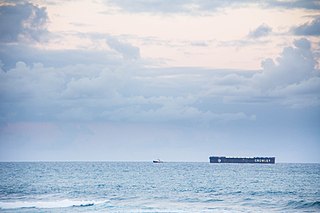
Crowley, legally Crowley Maritime Corporation, is based in Jacksonville, Florida. Founded in 1892, Crowley is primarily a family- and employee-owned vessel management, owner, and supply chain logistics services company, providing services globally. As of July 2016, Crowley was ranked as the 13th largest private company in Florida, employing approximately 5,300 people worldwide with revenues of $2.2 billion. It provides its services using a fleet of more than 300 vessels, consisting of RO-RO vessels, LO-LO vessels, tankers, Articulated Tug-Barges (ATBs), tugs and barges. Crowley's land-based facilities and equipment include terminals, warehouses, tank farms, and specialized vehicles.
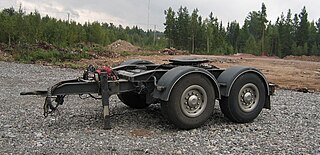
A dolly is an unpowered vehicle designed for connection to a tractor unit, truck or prime mover vehicle with strong traction power.

A tractor unit, also known as a truck unit, lorry unit, power unit, prime mover, ten-wheeler, semi-tractor, semi-truck, semi-lorry, tractor cab, truck cab, lorry cab, big rig tractor, big rig truck or big rig lorry or simply a tractor, truck, lorry, semi, big rig or rig, is a characteristically heavy-duty towing engine that provides motive power for hauling a towed or trailered load. These fall into two categories: heavy- and medium-duty military and commercial rear-wheel-drive semi-tractors used for hauling semi-trailers, and very heavy-duty typically off-road-capable, often 6×6, military and commercial tractor units, including ballast tractors.
The following outline is provided as an overview of and topical guide to transport:

A semi-trailer is a trailer without a front axle. The combination of a semi-trailer and a tractor truck is called a semi-trailer truck.

The fifth-wheel coupling provides the link between a semi-trailer and the towing truck, tractor unit, leading trailer or dolly. The coupling consists of a kingpin, a 2-or-3+1⁄2-inch-diameter vertical steel pin protruding from the bottom of the front of the semi-trailer, and a horseshoe-shaped coupling device called a fifth wheel on the rear of the towing vehicle. As the connected truck turns, the downward-facing surface of the semi-trailer rotates against the upward-facing surface of the fixed fifth wheel, which does not rotate. To reduce friction, grease is applied to the surface of the fifth wheel. The configuration is sometimes called a turn-table in Australia and New Zealand, especially if it is a rotating ball-race-bearing type. The advantage of this type of coupling is towing stability.

Towing is coupling two or more objects together so that they may be pulled by a designated power source or sources. The towing source may be a motorized land vehicle, vessel, animal, or human, and the load being anything that can be pulled. These may be joined by a chain, rope, bar, hitch, three-point, fifth wheel, coupling, drawbar, integrated platform, or other means of keeping the objects together while in motion.
Longer Heavier Vehicle (LHV) is a large goods vehicle category in the United Kingdom. Longer Heavier Vehicles are not currently allowed to operate on UK roads because they exceed the mandated limit of six axles and 44 tonnes of gross weight and length of 16.5 m for articulated lorries, or 18.75 m for drawbar lorries.

The Denby Eco-Link, dubbed the super lorry by the mainstream media, is a commercial vehicle designed and built by Denby Transport of the United Kingdom. The Eco-Link is a 60 tonne fully laden, 25.25m long, 8 axle B-Train type of semi-trailer truck, in which a tractor unit pulls two semi-trailers, using fifth wheel couplings on both trailers. As one prototype of the UK Longer Heavier Vehicle (LHV) vehicle definition, which are longer and heavier than normal Large Goods Vehicles, it is not currently permitted to be used in the UK. As of 2009, the largest ordinary lorries in the UK have 6 axles and a maximum laden weight of 44 tonnes, and can be 16.5m long as single trailer semi-trailer trucks, or 18.75m as drawbar lorries.



















